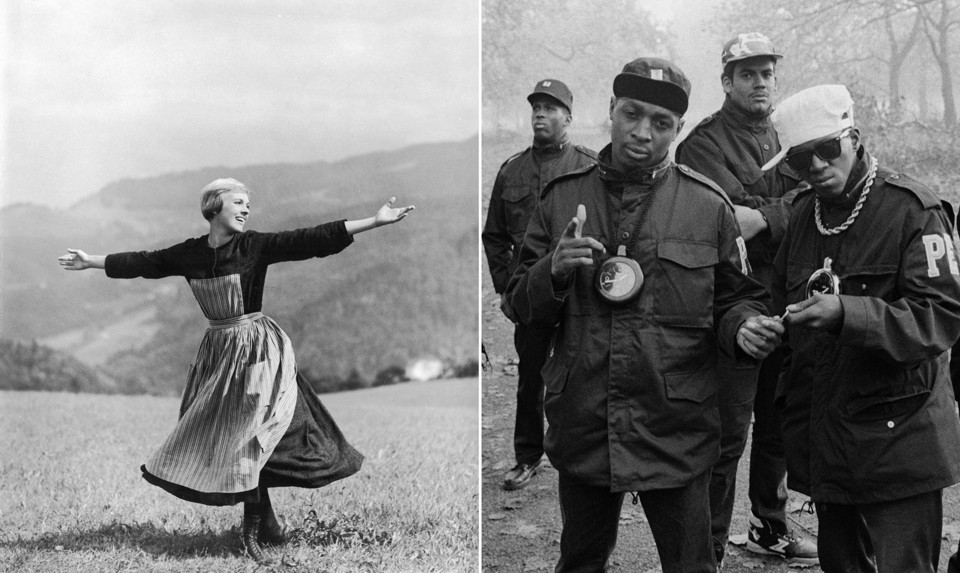What Art Can Do

All art is political. In tense, fractious times—like our current moment—all art is political. But even during those times when politics and the future of our country itself are not the source of constant worry and anxiety, art is still political. Art lives in the world, and we exist in the world, and we cannot create honest work about the world in which we live without reflecting it. If the work tells the truth, it will live on.
Public Enemy’s “911 Is a Joke,” George Orwell’s 1984, Rodgers and Hammerstein’s whole damn catalog—all are political works that tell the truth.
Yes, Rodgers and Hammerstein. Consider The Sound of Music. It isn’t just about climbing mountains and fording streams. Look beyond the adorable von Trapp children: It’s about the looming existential threat of Nazism. No longer relevant? A GIF of Captain von Trapp tearing up a Nazi flag is something we see 10 times a day on Twitter, because all sorts of Nazis are out there again in 2019. As last spring’s searing Broadway revival of Oklahoma! revealed, lying underneath Hammerstein’s elephant-eye-high corn and chirping birds is a lawless society becoming itself, bending its rules and procedures based on who is considered part of the community (Curly) and who is marginalized (poor Jud … seriously, poor Jud). Or consider your parents’ favorite, South Pacific. At its center, our hero, Nellie Forbush, must confront her own internalized racism when she learns that the new love of her life has biracial children from a previous marriage. Let your parents know if they forgot: Rodgers and Hammerstein musicals form the spine of Broadway’s “golden age,” and they also deeply engage with the politics of their era.

From The Sound of Music to the songs of Public Enemy, all art is political. (Hulton Archive / Getty; David Corio / Redferns)
My first Broadway musical, In the Heights, is an example of how time can reveal the politics inherent within a piece of art. When I began writing this musical, as a college project at Wesleyan University, it was an 80-minute collegiate love story with a promising mix of Latin music and hip-hop, but it was pretty sophomoric (which is appropriate; I was a sophomore). After college, I started from scratch with the director Thomas Kail and the playwright Quiara Alegría Hudes, and we shifted the show’s focus from the love story to Washington Heights, a neighborhood in Upper Manhattan where everyone is from everywhere. In the 20th century, Washington Heights was often home to the latest wave of immigrants. It was an Irish neighborhood; it was a Russian Jewish neighborhood (Yeshiva University is up there). If you take the Dominican store sign down you’ll see a sign for an Irish pub underneath it, and if you take that down you’ll find Hebrew. Washington Heights was heavily Dominican when I was growing up, and it remains so, with a vibrant Mexican and Latin American immigrant community as well.
As we wrote about this Upper Manhattan community on the verge of change, we looked to our musical-theater forebears. In Cabaret, the upheaval facing the characters in Berlin is the rise of the Nazi Party. In Fiddler on the Roof, the town of Anatevka struggles to hold on to its traditions as the world changes around it, and the threat of pogroms looms. For our musical world, upheaval comes in the form of gentrification. This is obviously different from fascism and pogroms; it’s not even in the same moral universe. How you begin to dramatize something as subtle and multifaceted as gentrification poses some tricky questions. We threw our characters into the same dilemma faced by their real-life working-class counterparts: What do we do when we can’t afford to live in the place we’ve lived all our lives, especially when we are the ones who make the neighborhood special and attractive to others? Each of the characters confronts this question differently: One sacrifices the family business to ensure his child’s educational future. Another relocates to the less expensive Bronx. Our narrator decides to stay, despite the odds, taking on the responsibility of telling this neighborhood’s stories and carrying on its traditions.
We received great reviews. If critics had a common criticism, it was that the show, its contemporary music aside, was somehow old-fashioned or “sentimental.” Gentrification, the businesses closing, the literal powerlessness as the characters face a blackout that affects only their neighborhood—these issues, always there in the material, didn’t register with most theater critics in 2008. In the Heights was considered a hit by Broadway standards. It didn’t leap off the Arts page and into the national conversation like Hamilton would, but we won some Tonys, recouped our investment, and had a wonderful three-year run at the Richard Rodgers Theatre, where Hamilton now lives. We posted our Broadway closing notice at the end of 2010.
What a difference 10 years makes.
Right now, Jon M. Chu is editing his feature-film adaptation of In the Heights, which is scheduled to be released in June. We spent a joyous summer shooting the film—on location, in our neighborhood—and issues that were always inherent in the text now stand out in bold-faced type. Gentrification has rendered Lower Manhattan, Harlem, and much of Brooklyn unrecognizable to the previous generations that called those neighborhoods home. The East Village of Jonathan Larson’s Rent is nonexistent, lettered avenues notwithstanding. And the narrative of immigrants coming to this country and making a better life for themselves—the backdrop of everything that happens in In the Heights, across three generations of stories—is somehow a radical narrative now.
Donald Trump came down the escalator to declare his presidential run, and in his first speech he demonized Mexicans: They’re rapists; they’re bringing drugs; they’re not sending their best people. We young Latinos had thought of our parents and grandparents as the latest wave making its home in this country, and we thought that we would be the next group to make this place a better place, to prove once again that the American dream wasn’t just a figment of some propagandist’s imagination. And now we’re in a different age when, for some, considering an immigrant a human being is a radical political act.
Consider this rap, written 12 years ago and delivered by Sonny, In the Heights’ youngest character, in a song called “96,000”:
Your kids are living without a good edumacation,
Change the station, teach ’em about gentrification,
The rent is escalatin’
The rich are penetratin’
We pay our corporations when we should be demonstratin’
What about immigration?
Politicians be hatin’
Racism in this nation’s gone from latent to blatant
It was always political. It was always there. Donald Trump made it even more true.
Trump uses language to destroy empathy. He criminalizes the impulse and imperative to seek asylum, to seek a place to live thousands of miles away because the alternative at home is worse. Through his lens, these seekers are not people; they’re “animals” or “bad hombres.”
What artists can do is bring stories to the table that are unshakably true—the sort of stories that, once you’ve heard them, won’t let you return to what you thought before. I think about the crisis on the border constantly. I think about the famous photograph of a little girl crying beside a Border Patrol truck. That picture went viral because it seemed to capture the horror of family separations. But it turned out that the girl wasn’t being separated from her mother—her mother had simply been ordered to put her daughter down while she was searched by agents. The family was in distress, and the border crisis was real, but people used the details of this particular incident to close themselves off from empathy. “Fake news,” they said. A child is crying for her mother, but that’s not enough to keep people from pushing empathy away. I believe great art is like bypass surgery. It allows us to go around all of the psychological distancing mechanisms that turn people cold to the most vulnerable among us.
At the end of the day, our job as artists is to tell the truth as we see it. If telling the truth is an inherently political act, so be it. Times may change and politics may change, but if we do our best to tell the truth as specifically as possible, time will reveal those truths and reverberate beyond the era in which we created them. We keep revisiting Shakespeare’s Macbeth because ruthless political ambition does not belong to any particular era. We keep listening to Public Enemy because systemic racism continues to rain tragedy on communities of color. We read Orwell’s 1984 and shiver at its diagnosis of doublethink, which we see coming out of the White House at this moment. And we listen to Rodgers and Hammerstein’s South Pacific, as Lieutenant Cable sings about racism, “You’ve got to be carefully taught.” It’s all art. It’s all political.
This article appears in the December 2019 print edition with the headline “What Art Can Do”
LIN-MANUEL MIRANDA is a Pulitzer Prize–, Grammy–, Emmy–, and Tony Award–winning composer, lyricist, and actor.
Like The Atlantic? Subscribe to The Atlantic Daily, our free weekday email newsletter.
